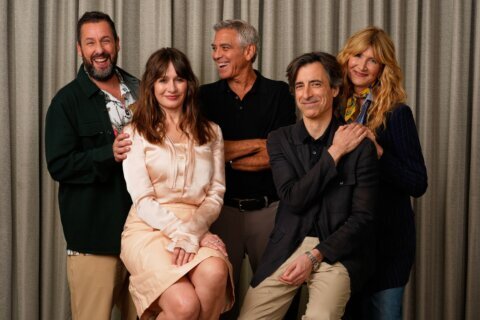WASHINGTON — It remains one of theater’s most vital social commentaries, cementing the legacies of Ruby Dee and Sidney Poitier on stage and screen.
This month, Lorraine Hansberry’s classic “A Raisin in the Sun” hits Arena Stage now through May 7.
“There are some plays where you go and your essence is validated,” actress Dawn Ursula told WTOP. “Your humanity is validated, yet you are also enlightened. This is one of those plays that does it. There are not that many that live for this long where people are still grasping to do it over and over again.”
The two most famous versions remain those starring Dee and Poitier, who anchored the original Broadway cast in 1959, before bringing it to the big screen in 1961 for a Cannes Palme d’Or nominee.
“It’s been many, many years [since I’ve seen Dee’s rendition], so it’s kind of a faint memory, which I’m kind of glad,” Ursula said. “You don’t have the iconic bubble of someone else floating around going, ‘Uh, I did that differently.’ ‘I’m sorry Ruby! I’m sorry!’ But yeah, amazing footsteps to try to follow in.”
Pulling its title from Langston Hughes’ poem “Harlem” (“What happens to a dream deferred? Does it dry up like a raisin in the sun?”), the play follows the Youngers, a poor black family living in a Chicago tenement and hoping to buy a new home using an insurance payment from the patriarch’s death.
“This money is going to really change their lives,” Ursula said. “Then life starts happening, the world comes in and there are laws enacted that make it hard to impossible. They want to buy a home. This is at a time when buying a home outside of the black neighborhood was impossible. There used to be laws that you could not purchase a home if you were not of the same race of the people who were already in these suburban white neighborhoods. They were legally not allowed to sell their homes.”
This societal conflict came from Hansberry’s own childhood experience.
“This was at a time when moving into a neighborhood like this was dangerous,” Ursula said. “Look up Lorraine Hansberry’s personal history of moving into a suburban white neighborhood, having the means, her parents were professionals, having the money, moving out there, and Lorraine as a child almost died from the people who did not want them there attacking the house. There are stories of her mother, when dad was not home, staying up all night with a pistol in case they were attacked.”
Hansberry writes of the mental and emotional toll it takes to live in such conditions.
“One of the most heartbreaking lines Ruth has, when she asks Lena about the home she purchased, is, ‘Is there a lot of sunlight?'” Ursula said. “Just think about what it means to live in a place where your home lacks sunlight, what that alone does to your psyche, does to your emotions, does to you being able to continue to have the energy and desire, let alone good attitude, to move forward every day.”
This claustrophobia is enhanced by director Tazewell Thompson and set designer Donald Eastman.
“We’re in the round, yet the space that we could’ve been moving around in is condensed even smaller on purpose, so there’s our living space within the actual round space,” Ursula said. “It’s these two cramped rooms, then there’s the offshoots of the other rooms we don’t see that are the separate bedrooms. So it helps to feel that tightness. There are times, kind of funny, when we’re in rehearsal where we’re bumping into each other! … ‘Oh, you’re there. I need to get here.’ We’re living this!”
She says so many American families can relate to the Younger family’s perseverance.
“It’s not for lack of working hard or making sacrifices,” Ursula said. “How many people do we know who are living with other relatives under the same roof? If we financially collaborate and live in these conditions — which make us terribly unhappy because we’re all on top of each other in two bedrooms and there’s six of us — if we do this for a little short time, we can get ahead to get to the other place.”
Most admirable, the play never becomes didactic. It deals with the everyday lives of ordinary folks.
“There are works of art … where the message is just really dumped heavily into your lap, [but] there’s nothing like that in this,” Ursula said. “Going to school, needing money for school, trying to kill the cockroaches you can’t seem to get rid of! … She incorporates these huge ideas and yet the mundane. In the first scene, we watch eggs being scrambled. It’s real, real, real life. Everybody can relate to it.”
Woven into these more mundane elements is a deceptively deep message revealed in poetic layers.
“In our moments of great need, I think any of us actually [can] have those moments when we speak poetically,” Ursula said. “When our hearts and our souls are just striving for something that’s just right out of reach. You’re like, wow, that was really profound. … She does that and it doesn’t feel out of place. It doesn’t feel like you’ve switched from one play to another. … Ms. Hansberry was a genius.”
Tragically, Hansberry died of cancer at age 34 in 1965. All the years later, she appears clairvoyant.
“Even though this was written by Lorraine in 1959 … this family and what they’re trying to achieve and obstacles is so incredibly present,” Ursula said. “[Walter Lee] works as a chauffeur. You could substitute him with an Uber driver today. … When Karl Lindner comes on stage and talks about ‘The Other,’ you get chills because what he’s saying back then, we are staring dead in the face right now.”
She finds particular prescience in the character of Joseph Asagai, who courts Beneatha Younger.
“He comes in and starts talking about change and the future,” Ursulsa said. “That one day the future could be that he is a great man and makes great change, and then other people will have different ideas of him, and they’ll want him out of office, and they’ll want to take over, and this is the cycle of life. It’s like Lorraine! Who are you that you thought of all of this?!? In so many ways, it’s so present.”
For this reason, she says “A Raisin in the Sun” is a classic that can never be performed too many times.
“I’ve had conversations with friends recently,” Ursula said. “They’re like, ‘Oh, ‘Raisin in the Sun,’ it’s been done so much,’ and I’m like, ‘You don’t understand.’ There’s a reason this is a classic and does not go away. You need to come have the experience. … There’s so much you’ve forgotten about this play.”
Click here for ticket information. Listen to the full conversation with lead actress Dawn Ursula below:








